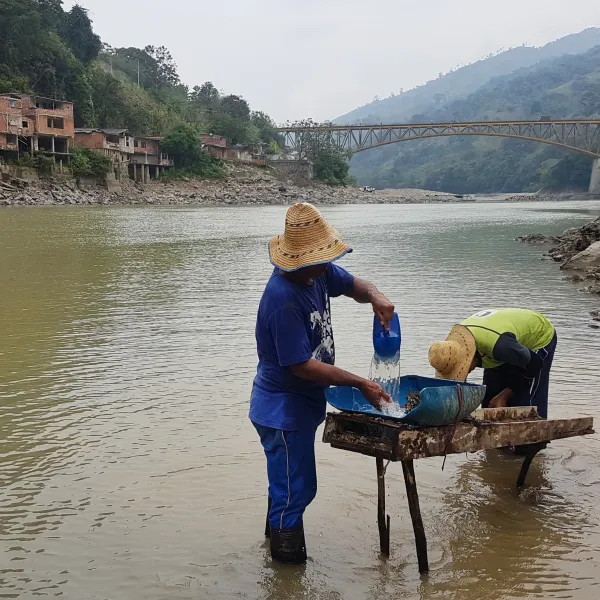
Project
Bram EbusSeeking justice for communities affected by the Hidroituango dam
The Cauca River is the second largest in Colombia. Many of the communities settled throughout its expansive watershed depend on the river for their livelihood, includingd fishing and agriculture.
Winding its way through the Andes mountains, the river courses through seven departments of Colombia, including Antioquia, now home to the Hidroituango Dam—a project that has created an unprecedented humanitarian crisis.
In May of 2018, an error in the dam’s construction caused floods, landslides, avalanches, and the evacuation of more than 25 thousand people. This tragedy exposed the inadequate evaluation of the project’s environmental impacts and the lack of environmental regulation in the dam’s authorization processes.
The project has led to systematic human rights violations, including the disproportionate use of force and an increase in violence against affected communities, who are represented by the Ríos Vivos (“Living Rivers”) Movement of Colombia.
Though construction is not complete, and electricity has not yet been generated, the dam has flooded more than 4,500 hectares of vegetation, releasing a significant amount of methane—a greenhouse gas that aggravates the global climate crisis.
And despite its inadequate implementation, IDB Invest, a private branch of the Inter-American Development Bank, invested millions of dollars into the hydroelectric project and facilitated the investment of billions more from other international banks.
Communities affected by Hidroituango have spent decades denouncing the serious problems caused by the dam, and will not waver in their struggle to defend their land and water.
Partners:

Related projects
Plan Colombia Aerial Herbicide Spraying Not Proved Safe for the Environment – Released to US Congress
For Immediate Release February 14, 2007 CONTACTS: Anna Cederstav, AIDA (510) 550-6700 [email protected] Astrid Puentes, AIDA (5255) 52120141 [email protected] PLAN COLOMBIA AERIAL HERBICIDE SPRAYING NOT PROVEN SAFE FOR THE ENVIRONMENT Critique of recent studies by international environmental NGO released to Congress today OAKLAND, CA, MÉXICO, D.F. - In December, the Colombian government violated a bilateral accord with Ecuador by spraying a mixture of herbicides intended to destroy coca crops within 10 kilometers of the Ecuadorian border. To justify the spraying, Colombia relied on studies by a team from the Inter-American Drug Abuse Control Commission (CICAD) of the Organization of American States (OAS), claiming that the spray mixture is safe. However, an independent review of CICAD’s recent studies, released to members of the U.S. Congress today, shows that the pesticide mixture being sprayed has not, in fact, been proven safe for the environment, and that Ecuador has substantial cause to oppose the spraying. According to the Interamerican Association for Environmental Defense (AIDA), the first CICAD Environmental and Human Health Assessment of the Aerial Spray Program for Coca and Poppy Control in Colombia, released in 2005, did not assess many of the greatest potential ecological and human health risks posed by the aerial eradication program in Colombia. Because of these omissions and the potential environmental risk of the spraying, the U.S. Congress requested further studies to better assess whether the mixture is truly safe for the environment. Preliminary results from the follow-up studies, released in August 2006, show that the mixture is indeed potentially harmful to the environment, and particularly to amphibians – the spray mixture killed 50 percent of the amphibians exposed in less than 96 hours. According to Earthjustice scientist and AIDA’s Program Director Anna Cederstav, “Contrary to what is argued by the government, this study shows sufficient cause for concern to suspend the sprayings due to potential environmental impacts, especially considering that Colombia has the second highest amphibian biodiversity in the world and the most threatened amphibian species.” Many other key questions about the environmental impacts of the spraying also remain unanswered, despite the U.S. Congressional mandate to conduct the studies. For example, the State Department has not provided adequate information about the location of and risk to sensitive water bodies and has done nothing to address whether other threatened species are likely to be harmed. Without these determinations, the claim by the Colombian government that it is safe to spray along the Ecuadorian border is misinformed. “Given the number of unanswered questions about the safety of the spraying, and considering the precautionary principle and the international obligation not to cause impacts to the territories of other States, the Colombian government should halt spraying immediately, and instead implement more effective and environmentally safe alternatives for coca eradication,” said Astrid Puentes, AIDA’s Legal Director.
Read moreAIDA critical of Colombian spraying in Ecuadorian border region
AIDA critical of Colombian spraying in Ecuadorian border region The Colombian government is violating a bilateral accord with Ecuador by spraying a mixture of herbicides intended to destroy coca crops within 10 kilometers of the Ecuadorian border. Colombia is relying on studies by a team from the Inter-American Drug Abuse Control Commission (CICAD) of the Organization of American States (OAS) to claim that the spray mixture is safe. AIDA’s independent review of CICAD's recent studies, however, shows that the pesticide mixture being sprayed has not, in fact, been proven safe for the environment, and that Ecuador has substantial cause to oppose the sprayings. The first CICAD Environmental and Human Health Assessment of the Aerial Spray Program for Coca and Poppy Control in Colombia, released in 2005, did not assess many of the greatest potential ecological and human health risks posed by the aerial eradication program in Colombia. The U.S. Congress requested further studies to determine whether the mixture is truly harmful to the environment. Preliminary results from the follow-up studies, released in August 2006, show that the mixture is indeed potentially harmful to the environment, and particularly to amphibians – the spray mixture killed 50 percent of the amphibians exposed within 96 hours. Additionally, the State Department has not provided adequate information about the location of and risk to sensitive water bodies and has done nothing to address whether other threatened species are likely to be harmed. Without these determinations, any claim by the Colombian government that the spray mixture is safe enough to spray along the Ecuadorian border is misinformed.
Read moreAIDA Calls for Alternative Development Programs in Colombia
AIDA Report Highlights Need for Alternative Programs in Colombia After six years of spraying herbicides over large areas of the Colombian countryside under "Plan Colombia," the aerial spraying program has failed to meet the goal of eliminating 50 percent of illicit crops in this country. Despite an investment of nearly US$1.2 billion, and the spraying of more than four times the initial area of coca crops, coca cultivation in Colombia continues, at nearly the same levels as when the program originated. Meanwhile, the spraying continues to cause severe social impacts and pose unknown environmental risk. AIDA has prepared a report analyzing some of the participatory, sustainable, alternative development programs that have proven more effective than aerial spraying. The report recommends that the U.S. and Colombian governments reevaluate the current policy and substantially increase support for such alternatives. The report highlights the need for a comprehensive approach to the problem of illegal crop cultivation, with a strategy that addresses the root-causes of the problem. The report provides detailed information and an analysis of five programs implemented by different actors, all of which can serve as models or provide lessons learned for new programs. Although improvements can still be made, alternative development programs have yielded concrete, positive results and have been far more cost-effective than the spraying program.
Read more